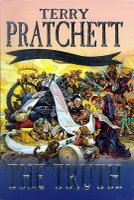Tipografia fantastica
Riccardo Crosa annovera tra i suoi autori preferiti Terry Pratchett. Per quanto riguarda il rapporto tra tipografia e fantasy, tra i romanzi che l'autore inglese ha scritto spicca "The Truth". The Truth, Pratchett's 25th Discworld novel, skewers the newspaper business. When printing comes to Ankh-Morpork, it "drag(s) the city kicking and screaming into the Century of the Fruitbat". Well, actually, out of the Century of the Fruitbat. As the Bursar remarks, if the era's almost over, it's high time they embraced its challenges.William de Worde, well-meaning younger son of reactionary nobility, has been providing a monthly newsletter to the elite using engraving. Then he is struck (and seriously bruised) by the power of the press. The dwarves responsible convince William to expand his letter and the Ankh-Morpork Times is born. Soon William has a staff, including Sacharissa Cripslock, a genteel young lady with a knack for headline writing, and photographer Otto Chriek. Otto's vampirism causes difficulties: flash pictures cause him to crumble to dust and need reconstitution, and he must battle his desire for blood, particularly Sacharissa's. When Lord Vetinari is accused of attempted murder, the City Watch investigates the peculiar circumstances, but William wants to know what really happened. The odds for his survival drop as his questions multiply.
The Truth, Pratchett's 25th Discworld novel, skewers the newspaper business. When printing comes to Ankh-Morpork, it "drag(s) the city kicking and screaming into the Century of the Fruitbat". Well, actually, out of the Century of the Fruitbat. As the Bursar remarks, if the era's almost over, it's high time they embraced its challenges.William de Worde, well-meaning younger son of reactionary nobility, has been providing a monthly newsletter to the elite using engraving. Then he is struck (and seriously bruised) by the power of the press. The dwarves responsible convince William to expand his letter and the Ankh-Morpork Times is born. Soon William has a staff, including Sacharissa Cripslock, a genteel young lady with a knack for headline writing, and photographer Otto Chriek. Otto's vampirism causes difficulties: flash pictures cause him to crumble to dust and need reconstitution, and he must battle his desire for blood, particularly Sacharissa's. When Lord Vetinari is accused of attempted murder, the City Watch investigates the peculiar circumstances, but William wants to know what really happened. The odds for his survival drop as his questions multiply.
Ankh-Morpork has weathered several influxes of technology in its time and now it has acquired a free press, dedicated newshounds, dwarf printers with not especially nasty tempers (for dwarves), and people who want to see their amusing vegetables in the "On a Lighter Note" section.
The Seventh Age of Discworld - The Modern Age
The Fifth Elephant
The Truth
Thief of Time
Night Watch
Monstrous Regiment In these most recent novels, the Discworld has entered the Modern Age, only a few years after it left the Early Medieval Period (!). The beginning of this Modern Age is marked by the introduction of the clacks machines in The Fifth Elephant. These do not attract terrible Things from the Dungeon Dimensions, nor are they a magically induced moment of hysteria like the rock music in Soul Music. They are here to stay and they will change the world. They lead to the introduction of newspapers and the invention of the printing press in The Truth and Ankh-Morpork's involvement in the Borogravian War in Monstrous Regiment. Even Commander His Grace the Duke Sir Samuel Vimes of the Ever-Increasing Titles has produced offspring and the feminist revolution is starting to make its way into places like Borogravia, one of the tiniest backwaters of the Discworld (so tiny and unimportant that in twenty-seven novels we've never heard of them before).
In these most recent novels, the Discworld has entered the Modern Age, only a few years after it left the Early Medieval Period (!). The beginning of this Modern Age is marked by the introduction of the clacks machines in The Fifth Elephant. These do not attract terrible Things from the Dungeon Dimensions, nor are they a magically induced moment of hysteria like the rock music in Soul Music. They are here to stay and they will change the world. They lead to the introduction of newspapers and the invention of the printing press in The Truth and Ankh-Morpork's involvement in the Borogravian War in Monstrous Regiment. Even Commander His Grace the Duke Sir Samuel Vimes of the Ever-Increasing Titles has produced offspring and the feminist revolution is starting to make its way into places like Borogravia, one of the tiniest backwaters of the Discworld (so tiny and unimportant that in twenty-seven novels we've never heard of them before).
The real printing history in the fantasy world of "The Truth" + [p. 19] "'Are you Gunilla Goodmountain?'"
+ [p. 19] "'Are you Gunilla Goodmountain?'"
Goodmountain -> Gutenberg. Johann Gutenberg is the German (claimed) inventor of movable type in the 1450s, most famously responsible for the Gutenberg Bibles.
+ [p. 19] "'Just give me a ninety-six-point lower-case h, will you, Caslong? Thank you,'"
Caslon is a well-known typeface named after its creator William Caslon, who released it in the 1730s. It was a highly successful and popular typeface throughout Europe and America: the first printings of the American Declaration of Independence and Constitution were set in Caslon. See also the annotations for p. 47 and p. 160.
+ [p. 47] "Boddony, who seemed to be second in command of the print room, [...]"
Another very aptly named dwarf: Bodoni is a well-known typeface designed at the end of the eighteenth century by Italian printer Giambattista Bodoni, who became the director of the press for the Duke of Parma, and who seems to have a reputation for elegance rather than accuracy.
+ [p. 160] "'You get them right now, Gowdie,' snapped Boddony."
This dwarf brings to mind Frederic William Goudy, the American type designer who designed several Goudy fonts, as well as Berkeley Old Style.

Nessun commento:
Posta un commento